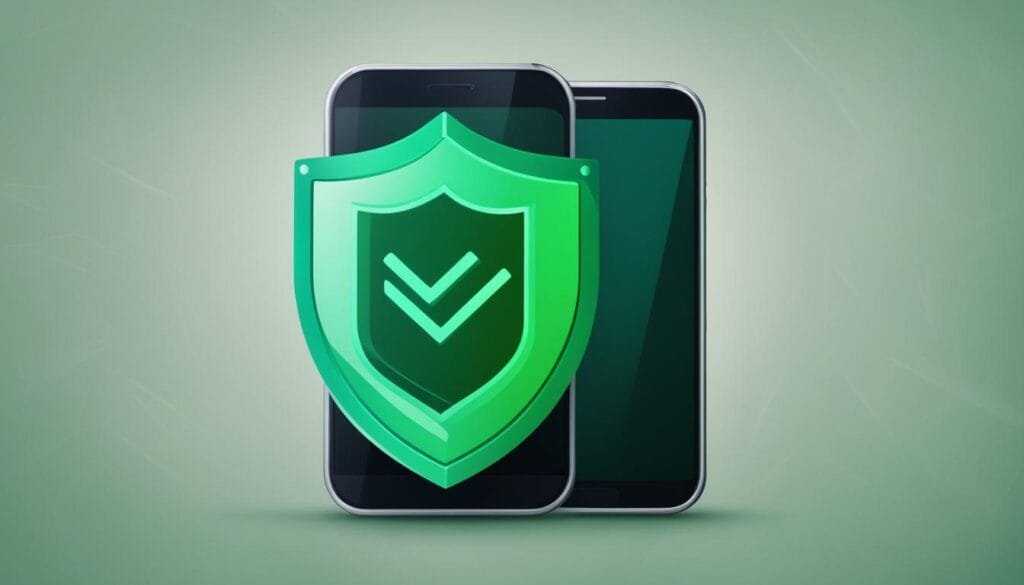In today’s digital era, mobile banking apps have revolutionized the way we manage our finances. With just a few taps on our smartphones, we can transfer funds, pay bills, and monitor our accounts. However, alongside this convenience comes the need for robust security measures to protect user data. With the increasing prevalence of data breaches and cyber attacks, it is crucial for banking apps to have strong security features in place to ensure the safety of sensitive information.
Key Takeaways:
- Banking apps face a growing threat from cyber attacks and data breaches.
- Robust security features are essential to protect user data in banking apps.
- Mobile app security should include measures such as data encryption, multi-factor authentication, and secure connections.
- Regular updates, user education, and compliance with regulations contribute to app security.
- Ensuring end-to-end encryption and secure development practices are equally important for app security.
The Growing Threat of Mobile Banking Security Attacks
Mobile banking apps have become a prime target for cybercriminals, with a significant increase in fraudulent transactions originating from these apps. According to reports, there has been a 600% surge in fraudulent transactions from mobile apps compared to three years ago. This alarming trend highlights the growing threat of mobile banking security attacks.
Various types of attacks have emerged, exploiting vulnerabilities in app code or targeting sensitive information beyond the app itself. Malware attacks, mobile banking trojans, deep attacks, screen loggers, key loggers, and overlay attacks have become increasingly common. These attacks can compromise user data, compromise financial transactions, and leave users vulnerable to identity theft.
As mobile banking apps continue to gain popularity and more individuals rely on them for financial transactions, it is essential to address the vulnerabilities that make these apps susceptible to attacks. This requires comprehensive security measures, including robust app development practices, regular security updates, and user education on safe banking practices.
Protecting Mobile Banking Apps
To safeguard mobile banking apps, developers should prioritize security by implementing the following measures:
- Regularly updating the app with the latest security patches and bug fixes to address any identified vulnerabilities.
- Implementing multi-factor authentication to add an extra layer of security beyond passwords.
- Encrypting sensitive user data to prevent unauthorized access.
- Using secure connections, such as HTTPS, to protect data during transmission.
- Conducting thorough security testing and penetration testing to identify and address any potential weaknesses.
By implementing these security measures, mobile banking apps can enhance their defenses against potential security attacks and provide users with a safer banking experience.
| Mobile Banking Security Best Practices | Benefits |
|---|---|
| Regular security updates | Addresses vulnerabilities and protects against emerging threats |
| Multi-factor authentication | Adds an extra layer of security and prevents unauthorized access |
| Data encryption | Protects sensitive user information from unauthorized access |
| Secure connections | Ensures the confidentiality and integrity of data during transmission |
| Thorough security testing | Identifies and addresses potential vulnerabilities in the app |
Trustonic & Lookout: Partners in App Security
When it comes to app security in the fintech industry, Trustonic and Lookout are two trusted names that stand out. Trustonic, with its secure operating system and Trustonic Application Protection (TAP), offers a comprehensive solution for secure app development. On the other hand, Lookout specializes in mobile app defense, providing services such as threat detection and prevention, anomaly detection, and anti-tampering measures. Together, these companies offer a powerful partnership for ensuring the security of banking and fintech applications.
Trustonic’s secure operating system, known as a TEE (Trusted Execution Environment), is integrated into billions of smart devices worldwide. This technology isolates critical code and data, creating a secure environment that protects against attacks and unauthorized access. By utilizing Trustonic’s TEE, app developers can enhance the security of their applications and protect user data.
Lookout, on the other hand, focuses on mobile app defense and offers a range of services to protect against evolving threats. Their expertise in threat detection and prevention helps identify and mitigate potential risks, ensuring that banking apps remain secure. With features such as anomaly detection and anti-tampering measures, Lookout strengthens the overall security posture of banking and fintech applications.
Benefits of the Trustonic and Lookout Partnership
- Comprehensive app security solutions for banking and fintech applications
- Integration of Trustonic’s secure operating system and TAP technology
- Specialized mobile app defense services from Lookout
- Enhanced protection against evolving threats
- Increased user confidence in the security of banking apps
In conclusion, the partnership between Trustonic and Lookout brings together the expertise and technologies needed to create secure and reliable banking apps. By leveraging Trustonic’s secure operating system and TAP technology, combined with Lookout’s comprehensive mobile app defense services, banking and fintech applications can enhance their security and protect user data. As the threat landscape continues to evolve, collaborating with trusted partners like Trustonic and Lookout is essential in ensuring the safety and security of app users in the fintech industry.
Security Flaws in Banking Apps Revealed by Which? Study
A recent study conducted by the consumer group Which? has shed light on some concerning security flaws in the mobile banking apps of major banks. The study evaluated the customer-facing security systems of 13 current account providers, uncovering issues with login processes, navigation, account management, and encryption.
Several notable vulnerabilities were identified, including weak password blocking, sending sensitive information via text messages, failure to log out customers after periods of inactivity, and allowing simultaneous access from multiple browsers or IP addresses. Among the lowest-scoring apps in the study were those of Virgin Money and TSB, which had a significant number of basic security flaws.
These findings highlight the importance of addressing and rectifying security flaws in banking apps to safeguard customer data from potential breaches or unauthorized access. User trust and confidence in banking apps can be significantly impacted by the presence of these vulnerabilities, making it imperative for banks to prioritize the implementation of robust security measures.
Table: Security Flaws in Banking Apps
| Bank | Security Flaws |
|---|---|
| Bank A | Weak password blocking |
| Bank B | Sending sensitive information via text messages |
| Bank C | Failure to log out customers after inactivity |
| Bank D | Allowing simultaneous access from multiple browsers or IP addresses |
| Virgin Money | Multiple basic security flaws |
| TSB | Multiple basic security flaws |
Banks must take swift action to address these security flaws and strengthen their customer-facing security systems. By implementing rigorous testing protocols, regular software updates, and adherence to industry best practices, banks can enhance the overall security of their banking apps and provide users with peace of mind when conducting transactions through mobile platforms.
Tips for Ensuring App Security for Banking Users
As mobile banking apps become more prevalent, ensuring the security of these apps is of utmost importance. Here are some tips for users to enhance the security of their mobile banking experience:
- Enable multi-factor authentication: By enabling this feature, users add an extra layer of security to their accounts. In addition to entering a password, multi-factor authentication requires an additional verification method, such as a fingerprint scan or a unique code sent to a registered device.
- Stay updated: Regularly updating the operating system and the mobile banking app itself is crucial. Updates often contain security patches that address vulnerabilities and protect against potential threats.
- Avoid insecure public Wi-Fi networks: Public Wi-Fi networks are often unsecured, making it easier for malicious third parties to intercept data. It is recommended to avoid using banking apps on public Wi-Fi networks and instead use secure connections, such as a personal cellular network or a trusted home network.
In addition to these user-driven measures, app developers also play a significant role in enhancing app security. Developers should guide and educate users on safe mobile banking practices and ensure that the app incorporates:
- Alerts and notifications: Users should receive real-time alerts and notifications about account activities, such as transactions or login attempts, to detect any suspicious or unauthorized activities.
- Secure password management: The app should encourage users to choose strong and unique passwords, and provide features such as password managers or password strength indicators to enhance password security.
By following these tips and adopting best practices, both users and developers can contribute to the overall security of mobile banking apps, protecting user data and ensuring a safer banking experience.
The Importance of End-to-End Encryption in Mobile Banking Apps
End-to-end encryption plays a crucial role in ensuring the security of data transfer in mobile banking apps. By encrypting the data at the sender’s device and decrypting it at the recipient’s device, end-to-end encryption ensures that sensitive information remains secure throughout the transmission process. This prevents unauthorized access and minimizes the risk of interception by malicious third parties.
In addition to end-to-end encryption, secure connections, such as HTTPS, should be implemented to further enhance data transfer security. Secure connections use cryptographic protocols to establish a secure channel between the user’s device and the banking app’s server. This safeguards the data from interception or modification during transit and provides users with the assurance that their information is being transmitted securely.
Implementing strong end-to-end encryption and secure connections is particularly crucial in the context of mobile banking apps. These apps handle sensitive financial information, including usernames, passwords, and transaction details. By ensuring that data is encrypted and transmitted securely, users can have confidence in the integrity and confidentiality of their personal and financial data.
“End-to-end encryption and secure connections are essential for protecting user data in mobile banking apps. These security measures provide users with the peace of mind that their information is safe and secure during data transmission.” – [Your Name], Cybersecurity Expert
In conclusion, the implementation of end-to-end encryption and secure connections is vital for ensuring the security of mobile banking apps. By encrypting data and establishing secure channels, users can trust that their sensitive information is protected from interception and unauthorized access. Mobile banking apps should prioritize the adoption of these security measures to instill confidence in users and maintain the integrity of their financial transactions.

The Role of Regulations and Secure Development Practices in App Security
Mobile banking regulations play a vital role in ensuring the security of banking apps. These regulations provide guidelines and standards that financial institutions must adhere to in order to protect user data and prevent unauthorized access. By complying with these regulations, app developers can implement the necessary security measures to safeguard sensitive information.
Regulations such as the Payment Card Industry Data Security Standard (PCI DSS) and the General Data Protection Regulation (GDPR) outline specific requirements for data protection and privacy. These regulations cover aspects such as encryption, secure storage of data, access controls, and regular security assessments. By following these guidelines, app developers can create a secure environment for banking transactions, reducing the risk of data breaches and fraud.
In addition to regulations, secure development practices are essential for app security. Thorough research and vetting of third-party providers ensure that only trusted and secure technologies are integrated into the app. Writing good code and conducting comprehensive testing help identify and address vulnerabilities before the app is released. Regular updates and patches further enhance the app’s security by addressing newly discovered threats and vulnerabilities.
By combining regulatory compliance with secure development practices, app developers can create banking apps that prioritize the protection of user data. These measures not only instill confidence in users but also help maintain the integrity of the banking system as a whole.
Conclusion
Building secure banking apps is of utmost importance in today’s digital landscape. With the increasing threats from hackers and malware, it is crucial to implement robust security measures to protect user data and ensure a safer banking experience.
End-to-end encryption, multi-factor authentication, and secure connections are some of the best practices in mobile app security. These measures help safeguard the transfer of sensitive data, minimize the risk of interception, and add an extra layer of protection for user information.
Regular updates, user education, compliance with regulations, and adherence to secure development practices are also essential. By following these guidelines, app developers can establish a strong foundation for secure and reliable banking applications.
While no app can provide absolute security, staying vigilant and implementing these best practices will go a long way in protecting user data and ensuring the trust and confidence of banking app users.
FAQ
Are mobile banking apps secure?
Mobile banking apps are vulnerable to security threats, but implementing robust security features can ensure the safety and protection of user data.
What are the common security attacks on mobile banking apps?
Common security attacks on mobile banking apps include malware, mobile banking trojans, deep attacks, screen loggers, key loggers, and overlay attacks.
Which companies specialize in app security for banking apps?
Trustonic and Lookout are leading companies in app security, offering solutions such as secure operating systems, threat detection, and prevention services.
Are there security flaws in banking apps?
Yes, a study by Which? revealed security flaws in some of the biggest banks’ apps, including issues with login, navigation, account management, and encryption.
What measures can users take to ensure the security of mobile banking apps?
Users can enable multi-factor authentication, update their operating system, avoid insecure Wi-Fi networks, and be cautious of common scams.
Why is end-to-end encryption important in mobile banking apps?
End-to-end encryption ensures the secure transfer of sensitive data by minimizing the risk of interception by malicious third parties.
How can app developers ensure security compliance?
App developers should adhere to mobile banking regulations, follow secure development practices, and conduct thorough research on third-party providers.
What is the importance of secure development practices?
Secure development practices, such as writing good code, conducting comprehensive testing, and following best practices, contribute to overall app security.
What Tips Can I Use to Create Unbreakable Passwords for My Banking Apps?
Creating strong passwords for banking apps is crucial in protecting your sensitive information. Follow these tips for unbreakable passwords: use a combination of letters, numbers, and symbols, avoid using personal information, make it at least 12 characters long, and use different passwords for each app.

